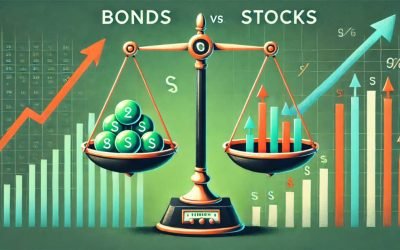Understanding the Fundamentals of Investment Risk
Investing in stocks can be a lucrative endeavour, but it is not without its risks. Understanding and assessing these risks before making an investment is crucial for any investor, whether novice or experienced. This guide aims to provide a comprehensive overview of the various types of investment risks and how to evaluate them effectively.
Types of Investment Risks
Investment risk can be broadly categorised into several types. Each type of risk has its own characteristics and implications for your investment portfolio.
Market Risk
Market risk, also known as systematic risk, refers to the potential for an investor to experience losses due to factors that affect the overall performance of the financial markets. This type of risk is inherent to all investments and cannot be eliminated through diversification.
Credit Risk
Credit risk, or default risk, is the possibility that a company or government will be unable to meet its debt obligations. This can lead to a loss of principal and interest, and it is particularly relevant for bond investors.
Liquidity Risk
Liquidity risk arises when an investor is unable to buy or sell an investment quickly enough to prevent or minimise a loss. This is often a concern for investments in smaller companies or less liquid markets.
Operational Risk
Operational risk is the risk of loss resulting from inadequate or failed internal processes, people, and systems, or from external events. This can include anything from technical failures to fraud.
Legal and Regulatory Risk
Legal and regulatory risk involves the potential for losses due to changes in laws and regulations that affect a company’s operations. This can impact everything from tax policies to environmental regulations.
Assessing Investment Risk
Assessing investment risk involves a combination of quantitative and qualitative analysis. Here are some key steps to consider:
Analyse Financial Statements
Reviewing a company’s financial statements is a fundamental step in assessing investment risk. Key financial statements include the balance sheet, income statement, and cash flow statement. These documents provide insights into a company’s financial health and operational efficiency.
- Balance Sheet: Provides a snapshot of a company’s assets, liabilities, and shareholders’ equity at a specific point in time.
- Income Statement: Shows a company’s revenues, expenses, and profits over a specific period.
- Cash Flow Statement: Details the inflows and outflows of cash, highlighting how well a company manages its cash position.
Evaluate Management and Corporate Governance
The quality of a company’s management team and its corporate governance practices can significantly impact its performance and risk profile. Look for companies with experienced leadership, transparent governance practices, and a track record of ethical behaviour.
Understand the Industry and Market Conditions
Industry and market conditions play a crucial role in determining the risk associated with an investment. Analyse the competitive landscape, market trends, and economic factors that could impact the industry. This will help you gauge the potential for growth and the risks involved.
Use Financial Ratios
Financial ratios are valuable tools for assessing a company’s financial health and risk. Some important ratios to consider include:
- Price-to-Earnings (P/E) Ratio: Measures a company’s current share price relative to its per-share earnings.
- Debt-to-Equity Ratio: Indicates the relative proportion of shareholders’ equity and debt used to finance a company’s assets.
- Return on Equity (ROE): Measures a company’s profitability by revealing how much profit it generates with the money shareholders have invested.
- Current Ratio: Assesses a company’s ability to pay short-term obligations with its current assets.
Consider Macroeconomic Factors
Macroeconomic factors such as interest rates, inflation, and economic growth can have a significant impact on investment risk. Stay informed about the broader economic environment and how it might affect your investments.
Risk Management Strategies
Effective risk management is essential for protecting your investment portfolio. Here are some strategies to consider:
Diversification
Diversification involves spreading your investments across different asset classes, industries, and geographic regions to reduce risk. By not putting all your eggs in one basket, you can mitigate the impact of poor performance in any single investment.
Asset Allocation
Asset allocation is the process of dividing your investment portfolio among different asset categories, such as stocks, bonds, and cash. The right asset allocation strategy depends on your risk tolerance, investment goals, and time horizon.
Regular Portfolio Review
Regularly reviewing and rebalancing your portfolio ensures that it remains aligned with your investment objectives and risk tolerance. This involves selling assets that have performed well and buying assets that have underperformed to maintain your desired asset allocation.
Use of Stop-Loss Orders
Stop-loss orders are a risk management tool that allows you to set a predetermined price at which your stock will be sold if it falls below a certain level. This can help limit potential losses and protect your investment.
Tools and Resources for Assessing Investment Risk
There are numerous tools and resources available to help investors assess investment risk. Some of these include:
Financial News and Analysis Platforms
Platforms such as Bloomberg, Reuters, and Financial Times provide up-to-date financial news, analysis, and data that can help you stay informed about market conditions and potential risks.
Stock Screeners
Stock screeners are online tools that allow you to filter stocks based on specific criteria, such as financial ratios, market capitalisation, and industry. This can help you identify potential investment opportunities and assess their risk profiles.
Investment Research Reports
Investment research reports from firms like Morningstar, Moody’s, and Standard & Poor’s provide in-depth analysis and ratings of companies and industries. These reports can offer valuable insights into the risks and potential rewards of different investments.
Risk Assessment Software
Risk assessment software, such as RiskMetrics and Value-at-Risk (VaR) models, can help you quantify and manage the risk in your investment portfolio. These tools use statistical methods to estimate potential losses and assess the impact of different risk factors.
Common Mistakes to Avoid When Assessing Investment Risk
Even experienced investors can make mistakes when assessing investment risk. Here are some common pitfalls to avoid:
Overlooking Diversification
Failing to diversify your portfolio can expose you to unnecessary risk. Ensure that your investments are spread across different asset classes, industries, and geographic regions to mitigate potential losses.
Ignoring Macroeconomic Factors
Macroeconomic factors can have a significant impact on your investments. Stay informed about the broader economic environment and consider how changes in interest rates, inflation, and economic growth might affect your portfolio.
Relying Solely on Historical Performance
While historical performance can provide valuable insights, it is not always indicative of future results. Consider other factors, such as market conditions, industry trends, and company fundamentals, when assessing investment risk.
Underestimating the Importance of Management Quality
The quality of a company’s management team can significantly impact its performance and risk profile. Look for companies with experienced leadership, transparent governance practices, and a track record of ethical behaviour.
Conclusion
Assessing investment risk before buying stocks is a critical step in the investment process. By understanding the different types of risks, analysing financial statements, evaluating management quality, and considering macroeconomic factors, you can make more informed investment decisions. Additionally, employing risk management strategies such as diversification, asset allocation, and regular portfolio reviews can help protect your investments and achieve your financial goals.
Remember, no investment is without risk, but with careful analysis and prudent risk management, you can navigate the complexities of the stock market and build a resilient investment portfolio.

Q&A Section
Q1: What is market risk?
A1: Market risk, also known as systematic risk, refers to the potential for an investor to experience losses due to factors that affect the overall performance of the financial markets. This type of risk is inherent to all investments and cannot be eliminated through diversification.
Q2: How can I assess a company’s financial health?
A2: You can assess a company’s financial health by reviewing its financial statements, including the balance sheet, income statement, and cash flow statement. Additionally, analysing financial ratios such as the P/E ratio, debt-to-equity ratio, and return on equity can provide valuable insights.
Q3: What is the importance of diversification in risk management?
A3: Diversification involves spreading your investments across different asset classes, industries, and geographic regions to reduce risk. By not putting all your eggs in one basket, you can mitigate the impact of poor performance in any single investment.
Q4: What tools can help me assess investment risk?
A4: Tools such as financial news and analysis platforms, stock screeners, investment research reports, and risk assessment software can help you assess investment risk. These resources provide valuable data, analysis, and insights to inform your investment decisions.
Q5: Why is it important to consider macroeconomic factors when assessing investment risk?
A5: Macroeconomic factors such as interest rates, inflation, and economic growth can have a significant impact on investment risk. Staying informed about the broader economic environment helps you understand how these factors might affect your investments and make more informed decisions.
Further reading about Stockmarket risks:
Here are some informative articles on assessing investment risk before buying stocks:
- Investopedia – Determining Risk and the Risk Pyramid: This article outlines how to balance risk and reward using the “investment pyramid” strategy, placing low-risk assets like cash at the base and riskier assets like growth stocks at the top. It also explains the importance of considering your risk tolerance, time horizon, and liquidity needs when making investment decisions(Investopedia).
- Investopedia – How Investment Risk is Quantified: This piece explores key concepts such as beta, alpha, and standard deviation to quantify risk. It introduces modern portfolio theory and explains how diversification and efficient frontier models help manage risk across portfolios(Investopedia).
- SoFi – How to Evaluate a Stock Before You Buy: This article provides a practical guide to stock evaluation, focusing on financial ratios like price-to-earnings (P/E), earnings per share (EPS), and return on equity (ROE). It emphasizes the importance of both quantitative and qualitative research in assessing a stock’s value(SoFi).
- SmartAsset – Risks of Investing in Stocks and How to Avoid Them: This article breaks down six common types of risk, including business, downside, economic, and inflationary risk. It also discusses the risks of being overly conservative with investments(SmartAsset).
These articles will help you understand the various risks involved and how to evaluate them before making stock investments.















 How to trade CFD? (00:49)
How to trade CFD? (00:49) How to trade binary options*? (01:22)
How to trade binary options*? (01:22) Forex. How to start? (01:01)
Forex. How to start? (01:01)